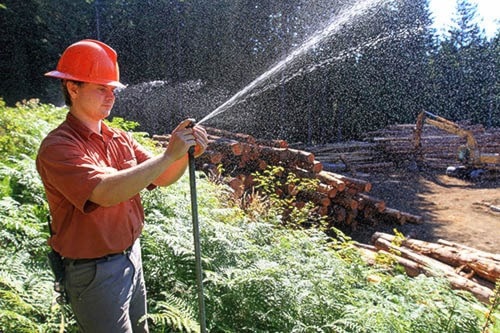The Maple Ridge Fire Department may want to steal a phrase from local police forces: no call to small.
Because if people call them when they see a small brush fire or bark-mulch blaze, or if a small patch of grass catches alight, the fire department can jump on it before it grows to a major fire.
Having the eyes and ears of the public helping out is an important part of the department’s strategy as it tries to make it through what’s becoming a long, hot summer, says Deputy Fire Chief Howard Exner.
With weeks of no rain, Maple Ridge’s forests can become even drier and more dangerous as humidity levels drop.
“There’s still a lot of dryout left to do,” Exner said.
“As the temperature continues to climb during the day, the humidity could still drop.”
On Thursday, the fire department issued a total fire ban on any camp or cook fires, fireworks or any flame of any kind in both rural and urban parts of Maple Ridge.
B.C. Parks followed on Monday, banning campfires from within Golden Ears Provincial Park.
“From an operational point of view, all the necessary training is complete for an initial fire attack,” said Exner.
“We’ve got the planning part done. Hopefully, we don’t have to go the operational part.”
Exner said industry working in the areas where the forest meets the built-up areas of Maple Ridge has been told to set up a fire watch when operating.
But after a few days of extreme fire conditions, all of that work has to stop completely until conditions improve. That includes any logging, mowing, welding, cutting or blasting.
“We’re notifying people upfront right now, trying to tell everybody that is where we’re heading.”
Companies that don’t follow those orders will be fined.
Maple Ridge fire department has one ATV, a Polaris Ranger, which can drive on the trails and get firefighters into the bush so they can squelch any fires immediately. That can carry 300 litres of water or also tap into a stream or brook in the bush.
Danger areas are not only in the forest but any open areas, farmers fields or grassy meadows. “It’s not necessarily just trees.”
Last year, Maple Ridge council created a new permit area for new houses that face the forest to have some measures to be able to withstand a wildfire.
But Exner said it’s too soon for those new rules to have any impact on area’s ability to survive a fire.
The wildfire development permit areas require new homes that are built next to the forest to use fire-resistent exterior materials, fire resistent roofs and fire-smart landscaping. Ten-metre buffer areas will also be required to separate new suburbs from forests.
The wildfire development permit area derives from Maple Ridge’s Community Wildfire Protection Plan passed in 2007. That plan came from the Firestorm 2003 report written by former Manitoba premier Gary Filmon in the wake of the devastating wildfire that tore through Kelowna that year.
“We’ve got our guard up high and that’s what we’re looking to run with right now,” said Exner.
Staff at the UBC Malcolm Knapp Research Forest are also on high alert.
“We have our own capacity for initial attack here,” said director Paul Lawson.
“We’ve basically shut down all of our forest activities,” during the current extreme conditions.
The forest’s sawmill has been surrounded by sprinklers, while there’s a campfire ban in place at Loon Lake.
Lawson said two students work seven days a week on fire patrol, while eight people have been trained to respond to a wildfire. Three tanker trailers, a municipal fire truck and 10 water pumps round out the anti-fire arsenal.
There’s a lot at risk, Lawson added.
“We’re trying our best to stay on top of things here.”
As hot and dry as it is, Lawson said the fire-rating index for the forest is at about 105, still below the 170 level reached in the summer of 2003, when wildfires hit the Kelowna area.
The index is based on temperature, humidity, wind and precipitation.
Conditions are not expected to change for awhile.
The last two weeks of July and the first two weeks of August are usually the driest, said Lawson.
“We’re expecting another eight to 10 weeks of high, extreme rating here.”
More than 100 long-term research forests are underway at the research forest.
